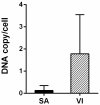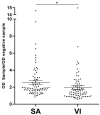Investigation on Spontaneous Abortion and Human Papillomavirus Infection
- PMID: 32854278
- PMCID: PMC7563606
- DOI: 10.3390/vaccines8030473
Investigation on Spontaneous Abortion and Human Papillomavirus Infection
Abstract
Viral infections are considered to be risk factors for spontaneous abortion (SA). Conflicting results have been reported on the association between Human Papillomavirus (HPV) and SA. HPV DNA was investigated in matched chorionic villi tissues and peripheral blood mononuclear cells (PBMCs) from women who experienced SA (n = 80, cases) and women who underwent a voluntary interruption of pregnancy (VI; n = 80, controls) by qualitative PCR and quantitative droplet digital PCR (ddPCR). Viral genotyping was performed using real-time PCR in HPV-positive samples. Specific IgG antibodies against HPV16 were investigated in sera from SA (n = 80) and VI (n = 80) females using indirect ELISA assays. None of the DNA samples from SA subjects was HPV-positive (0/80), whilst HPV DNA was detected in 2.5% of VI women (p > 0.05), with a mean viral DNA load of 7.12 copy/cell. VI samples (n = 2) were found to be positive for the HPV45 genotype. The ddPCR assay revealed a higher number of HPV-positive samples. HPV DNA was detected in 3.7% and 5% of SA and VI chorionic tissues, respectively, with mean viral DNA loads of 0.13 copy/cell in SA and 1.79 copy/cell in VI (p >0.05) samples. All DNA samples from the PBMCs of SA and VI females tested HPV-negative by both PCR and ddPCR. The overall prevalence of serum anti-HPV16 IgG antibodies was 37.5% in SA and 30% in VI (p > 0.05) women. For the first time, HPV DNA was detected and quantitatively analyzed using ddPCR in chorionic villi tissues and PBMCs from SA and VI women. Circulating IgG antibodies against HPV16 were detected in sera from SA and VI females. Our results suggest that HPV infection in chorionic villi may be a rare event. Accordingly, it is likely that HPV has no significant role in SA.
Keywords: 9-valent HPV vaccine; 9vHPV vaccine; ELISA; HPV; PBMC; antibody; chorionic villi; droplet digital PCR; human papillomavirus; infection; quadrivalent HPV vaccine; spontaneous abortion; voluntary interruption of pregnancy.
Conflict of interest statement
All authors have no potential conflicts of interest.
Figures


Similar articles
-
Footprints of BK and JC polyomaviruses in specimens from females affected by spontaneous abortion.Hum Reprod. 2019 Mar 1;34(3):433-440. doi: 10.1093/humrep/dey375. Hum Reprod. 2019. PMID: 30590693
-
Droplet-digital PCR assay to detect Merkel cell polyomavirus sequences in chorionic villi from spontaneous abortion affected females.J Cell Physiol. 2020 Mar;235(3):1888-1894. doi: 10.1002/jcp.29213. Epub 2019 Sep 23. J Cell Physiol. 2020. PMID: 31549405
-
Investigation on silent bacterial infections in specimens from pregnant women affected by spontaneous miscarriage.J Cell Physiol. 2018 Jan;234(1):100-107. doi: 10.1002/jcp.26952. Epub 2018 Aug 5. J Cell Physiol. 2018. PMID: 30078192
-
Simultaneous Detection and Viral DNA Load Quantification of Different Human Papillomavirus Types in Clinical Specimens by the High Analytical Droplet Digital PCR Method.Front Microbiol. 2020 Nov 19;11:591452. doi: 10.3389/fmicb.2020.591452. eCollection 2020. Front Microbiol. 2020. PMID: 33329471 Free PMC article.
-
Significantly Low Levels of IgG Antibodies Against Oncogenic Merkel Cell Polyomavirus in Sera From Females Affected by Spontaneous Abortion.Front Microbiol. 2021 Dec 14;12:789991. doi: 10.3389/fmicb.2021.789991. eCollection 2021. Front Microbiol. 2021. PMID: 34970247 Free PMC article.
Cited by
-
A cross-sectional analysis of preterm birth incidence and survival in Al Kharj, Saudi Arabia.Saudi Med J. 2024 Jul;45(7):710-718. doi: 10.15537/smj.2024.45.7.20240194. Saudi Med J. 2024. PMID: 38955439 Free PMC article.
-
Epigenetic Dysregulations in Merkel Cell Polyomavirus-Driven Merkel Cell Carcinoma.Int J Mol Sci. 2021 Oct 24;22(21):11464. doi: 10.3390/ijms222111464. Int J Mol Sci. 2021. PMID: 34768895 Free PMC article. Review.
-
The Role of Histone Post-Translational Modifications in Merkel Cell Carcinoma.Front Oncol. 2022 Mar 8;12:832047. doi: 10.3389/fonc.2022.832047. eCollection 2022. Front Oncol. 2022. PMID: 35350569 Free PMC article. Review.
-
The association between human papillomavirus and bladder cancer: Evidence from meta-analysis and two-sample mendelian randomization.J Med Virol. 2023 Jan;95(1):e28208. doi: 10.1002/jmv.28208. Epub 2022 Oct 25. J Med Virol. 2023. PMID: 36226344 Free PMC article.
-
Cervical Intraepithelial Neoplasia Grade 3 in a HPV-Vaccinated Patient: A Case Report.Medicina (Kaunas). 2022 Feb 23;58(3):339. doi: 10.3390/medicina58030339. Medicina (Kaunas). 2022. PMID: 35334516 Free PMC article.
References
-
- Contini C., Rotondo J.C., Magagnoli F., Maritati M., Seraceni S., Graziano A., Poggi A., Capucci R., Vesce F., Tognon M., et al. Investigation on silent bacterial infections in specimens from pregnant women affected by spontaneous miscarriage. J. Cell. Physiol. 2018;234:100–107. doi: 10.1002/jcp.26952. - DOI - PubMed
-
- Tagliapietra A., Rotondo J.C., Bononi I., Mazzoni E., Magagnoli F., Gonzalez L.O., Contini C., Vesce F., Tognon M., Martini F. Droplet-digital PCR assay to detect Merkel cell polyomavirus sequences in chorionic villi from spontaneous abortion affected females. J. Cell. Physiol. 2020;34:433–440. doi: 10.1002/jcp.29213. - DOI - PubMed
Grants and funding
LinkOut - more resources
Full Text Sources

